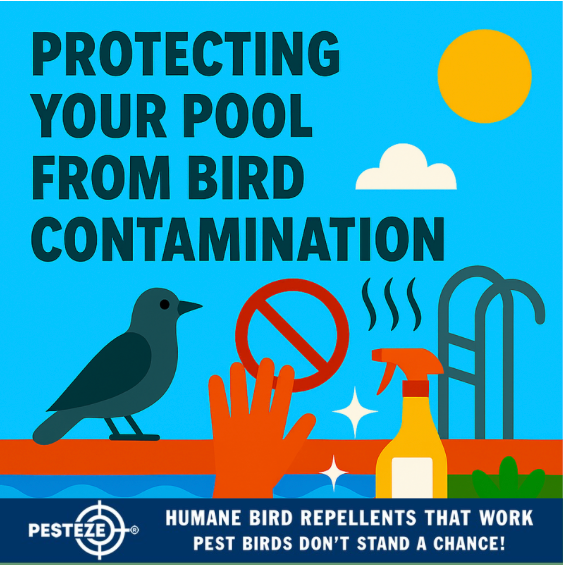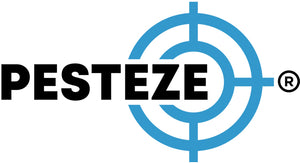PROTECTING YOUR POOL FROM BIRD CONTAMINATION

PROTECTING YOUR POOL FROM BIRD CONTAMINATION
SUMMARY
Birds view swimming pools as attractive water sources and bathing areas, but their presence creates serious health hazards through contamination and disease transmission. This specialized guide provides effective strategies to keep birds away from pool areas while maintaining water quality and swimmer safety.
FEATURES
- Water Quality Protection: Prevents bacterial contamination and disease transmission from bird droppings and debris.
- Health Safety Assurance: Eliminates risks of swimmer illness from bird-borne pathogens and parasites.
- Pool Equipment Security: Protects filtration systems, covers, and pool accessories from bird damage.
- Aesthetic Maintenance: Keeps pool areas clean and inviting by preventing unsanitary bird activity.
- Chemical Balance Stability: Reduces cleaning chemical usage and maintains proper water chemistry longer.
- Seasonal Solutions: Year-round protection strategies adapted to migration patterns and weather conditions.
GUIDE DESCRIPTION
Swimming pools attract birds seeking water sources, especially during hot weather or drought conditions, but bird activity introduces dangerous pathogens including E. coli, salmonella, and cryptosporidium that pose serious health risks to swimmers. Effective pool protection requires multi-layered approaches that eliminate both attraction factors and access opportunities.
Physical barriers provide the most reliable protection for pool areas when swimming isn't occurring. Pool covers with proper tensioning systems completely exclude birds while maintaining water temperature and reducing evaporation. Retractable canopy systems offer protection during non-use periods while allowing easy removal for swimming activities.
Water circulation strategies make pools less attractive to birds by eliminating the still water conditions they prefer for drinking and bathing. Continuous filtration during daylight hours creates surface movement that birds find uncomfortable, while fountain features and water jets provide additional deterrence through noise and splash patterns.
Perimeter deterrents discourage birds from approaching pool areas before they can access the water. Reflective tape along pool fencing, spinning deterrent devices, and motion-activated sprinklers create multiple layers of discouragement around the pool perimeter. Strategic placement ensures coverage without interfering with normal pool maintenance and swimmer access.
Alternative water sources can redirect bird activity away from swimming pools while supporting local wildlife needs. Bird baths, shallow water features, or dripping water systems positioned away from pool areas provide attractive alternatives that satisfy birds' water needs without compromising pool sanitation.
Pool chemistry management becomes more critical when bird contamination occurs. Immediate shock treatment with chlorine or other sanitizers helps eliminate pathogens introduced by bird droppings, while increased filtration cyclesremove physical contamination. Professional water testing may be necessary after significant contamination events.
Cleaning protocols for bird-contaminated pools require specific procedures to ensure complete sanitization. Remove visible contamination immediately using pool skimmers and vacuum systems, then superchlorinate the wateraccording to health department guidelines. Filter cleaning or replacement may be necessary after contamination events.
Seasonal adaptation addresses changing bird behavior patterns throughout the year. Spring migration periods often bring increased bird activity around water sources, while summer drought conditions make pools especially attractive to thirsty birds. Fall preparation should include barrier installation before winter when pool usage decreases.
Pool cover integration with bird deterrent systems provides comprehensive protection during extended non-use periods. Automatic cover systems with bird-resistant materials eliminate access while simplifying daily maintenance routines. Manual covers should be inspected regularly for damage that could allow bird entry.
Landscaping considerations around pool areas can influence bird attraction and activity patterns. Remove or relocate bird-attracting plants like berry-producing shrubs near pool areas, while strategic placement of thorny or dense vegetation can create natural barriers that discourage bird approach routes.
Professional maintenance services often include bird control as part of comprehensive pool care programs. Weekly cleaning schedules, water testing, and equipment inspection help identify bird-related problems early when solutions are most effective. Emergency response protocols for contamination events ensure rapid water quality restoration.
Health department compliance may require specific procedures when bird contamination occurs in commercial pool facilities. Documentation of cleaning procedures, water testing results, and contamination response demonstrates due diligence in maintaining safe swimming conditions. Professional consultation ensures compliance with local health regulations.
Insurance considerations may favor documented bird control efforts that demonstrate proactive water quality management. Regular maintenance records, professional service contracts, and contamination response documentation provide liability protection while potentially qualifying for premium reductions.
- Pukhraj Sharma


Comments 0